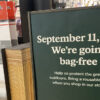
It was a sobering read. In 1950, Samuel Glasstone’s “The Effects of Atomic Weapons” provided the first unclassified explanation of the physical destruction caused by nuclear weapons. The book’s descriptions were detailed, clinically precise … and terrifying.
For decades, it remained the authoritative source on the topic. Only one problem: It wasn’t always right. Take this conclusion: “The shock wave produced by an air-burst atomic bomb is the most important agent in producing destruction. …”
For years, military planners used that insight to estimate the scope of destruction wrought by a mushroom cloud. They were way off.
In “Whole World on Fire” (2003), Lynn Eden argues that focusing on shock waves led planners to significantly underestimate the destructive power of atomic warfare because they didn’t take into account the damage done by mass fire.
Analysts had concluded it was difficult to predict the effects of fire and, because it was only a secondary agent of destruction, they simply omitted fire from their calculations.
Big mistake, Eden says. Recent research suggests that nuclear weapons are much more destructive than previously thought because of the effect of mass fire. At the moment of detonation, the heart of an atomic fireball is four to five times hotter than the sun. It generates a firestorm of hurricane-force winds. Air temperature soars above the boiling point.
Both Washington and Tehran have much to learn from this. The people of Iran should realize the terrible price they may pay due to their president’s relentless pursuit of nuclear weapons. For Mahmoud Ahmadinejad, nukes are more than a status symbol. He views them as a useful tool. He publicly yearns to bring about the “death of Israel” and live in “a world without America.”
Nukes are the way to reach these goals. Give this delusional dreamer a nuclear weapon and a missile to deliver it, and he’ll be only too eager to threaten his enemies with nuclear holocaust.
That, of course, would only invite atomic retaliation … the type that would obliterate Iran. Ahmadinejad is an existential threat to his own people. And that’s reason enough for Iranians to take back their country.
The lesson for Washington is that the United States, a long-established nuclear power, must act like a responsible one. President Obama has started a mad dash down the “road to zero” — with the announced goal of eliminating our nuclear arsenal. It’s a path more likely to end in a nuclear firestorm than in peace.
Why? The danger starts with the administration’s refusal to fully modernize our nuclear weapons. Our aging inventory is increasingly less usable and reliable. The continuing erosion of a credible deterrent force will only invite aggression.
Moreover, slashing U.S. arsenals may well spur a news arms race. It may encourage emerging atomic enemies such as Iran and North Korea to “pick up the pace” to become our nuclear equals. That in turn could spark other nations wary of these rogue regimes to fast-track their own nuclear programs. Instead of easing tensions, our nuclear drawdown could ratchet up worldwide instability.
The administration has compounded its nuclear error by hobbling our missile defense program. War gaming exercises consistently show missile defenses not only deter attacks, they deter others from even building up their arsenals. Why build missiles when they’ll just be shot down?
A world on fire is horrific vision of the future. The Iranian administration views it as glorious, while our administration steadfastly averts its gaze. It should worry peace-loving Iranians and Americans alike.























